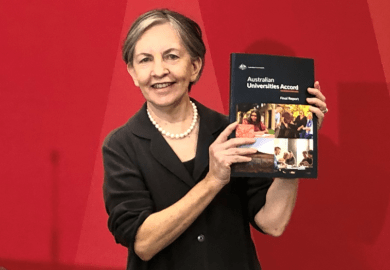A proposed levy on international students’ fees remains the most fiercely contested element of the Australian Universities Accord’s final report, despite evolving into a far broader co-contribution scheme.
The report recommends a Higher Education Future Fund to finance university infrastructure and student accommodation. The target capital of A$10 billion (£5.2 billion) would come from universities’ “untied own source revenue”, based on their individual “capacity to contribute”, and matching federal government funding.
The concept expands on a suggestion in the accord’s interim report last July. Its rationale is that resources in a sector with uneven wealth should be shared around to address the lack of dedicated infrastructure funding.
The proposal could see universities relinquishing a percentage of their earnings not just from international students but also from investments, patents, contracts, cafe leases, parking meters and domestic postgraduates’ fees.
The report says universities would be required to pay such levies only once broader reforms were in place. But University of Melbourne vice-chancellor Duncan Maskell warned that the “new tax on universities” would weaken Australia’s “productivity, innovative potential and prosperity”.
University of Sydney vice-chancellor Mark Scott, chair of the Group of Eight, which represents research-intensive universities, said “taxing the very system the report identified as underfunded” was “extremely poor public policy. It will…undermine our hard-won and enduring successes in international education and damage our global reputation [and] our capacity to retain skilled graduates to underpin a productivity revival.”
Australian National University (ANU) analyst Andrew Norton also opposed the proposal. “We’ve had experience with these funds before. Eventually, the government closes them down and takes all the cash.”
He said it was unrealistic to expect the government to fork out A$5 billion for an infrastructure fund on top of other accord recommendations costing tens of billions of dollars. “It’s almost as if they’ve set it up to stop it happening.”
But University of Technology Sydney vice-chancellor Andrew Parfitt, one of the levy’s original proponents, said his idea had always involved government co-investment.
“It’s been simplified significantly in the narrative in recent times around a tax on the rich, but it’s actually a structured investment proposition. [There are] guard rails around affordability [and] how it will be built up over a period of time. It’s…a sensible policy direction to ensure that we have the capacity to pick up opportunities as they arise, and manage risks as they materialise.”
Universities Australia chair David Lloyd said it was significant that an independent panel had recognised the need for such a mechanism. “I don’t think a single institution in the country would argue against the creation of a higher education future fund, [but] individual institutions will have very different views on how that should be funded.
“As it’s articulated, it’s a leveraged fund. That gets a tick. You can only take out if you put in. That gets a tick. And it’s linked to your ability to pay, which gets a tick. There’s obviously been quite a lot of consideration.”
Education minister Jason Clare said he had an “open mind” about the proposal. “Some universities hate it; other universities love it. Everybody understands we need more affordable student accommodation. The question is how you do it,” he said.
He told the ABC that he would be unlikely to include philanthropic contributions in any levy. “As you would rightly expect, [donors] want [their money] spent on certain things.”
Mr Clare signalled support for a proposal to ease pressure on low-income graduates by reorganising student loan repayments. Under the current approach, former students repay a percentage of their entire income once their earnings exceed the repayment threshold. The report recommends a “marginal” system in which they repay only a percentage of their earnings above the threshold.
Modelling by ANU emeritus professor Bruce Chapman, architect of Australia’s student loans system, had found that graduates on A$75,000 salaries would repay about A$1,000 each year under this approach. “That’s something that could provide an immediate cost-of-living benefit for people after they finish uni,” Mr Clare said.
The report does not specify percentages or thresholds. Professor Norton said that unless a marginal system included higher repayment rates and reduced thresholds, low-income graduates could pay towards loans for their entire careers and retire owing more than when they started.
“We’ve got all this fuss about indexation and ongoing debt,” he said. “For some people, this system would make that worse, because they’ll be repaying less each year. There’ll be more indexation [making] it harder…to ever fully repay. That would need a lot of pretty careful modelling to work out implications for both students and the commonwealth.”
john.ross@timeshighereducation.com
Australian Universities Accord: key proposals at a glance
- New targets – including 1.8 million subsidised domestic students by 2050, with parity participation by equity groups, 80 per cent of working-age Australians having tertiary qualifications and 55 per cent of 25- to 34-year-old Australians having degrees
- Australian Tertiary Education Commission – with roles including policy development, planning, accountability, pricing, funding allocation, data collection and negotiation of mission-based compacts
- Needs-based funding – subsidies to cover additional costs of teaching disadvantaged, Indigenous and disabled students and of teaching in regional areas
- Fee-free preparatory courses – fully funded enabling courses, widely available at no cost
- Loans and fees – including unspecified changes to Job-ready Graduates package, introduction of a marginal repayment system and elimination of indexation charges on payments already made
- Income support reforms – including changes to eligibility criteria, increased PhD stipends and technical analysis of further options
- Financial support for students undertaking unpaid placements – including payments from state governments and private sector employers
- Additional research funding – including more grants for basic research and research overheads and a fund to incentivise impactful research
- Higher Education Future Fund – A$10 billion nest egg to finance infrastructure and student accommodation, co-funded by universities and the federal government
- Implementation advisory committee – to guide education minister on implementation issues
Register to continue
Why register?
- Registration is free and only takes a moment
- Once registered, you can read 3 articles a month
- Sign up for our newsletter
Subscribe
Or subscribe for unlimited access to:
- Unlimited access to news, views, insights & reviews
- Digital editions
- Digital access to THE’s university and college rankings analysis
Already registered or a current subscriber?










